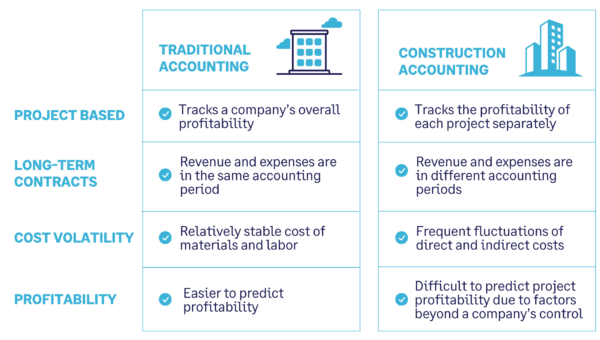A Comprehensive Guide to Building And Construction Bookkeeping: Enhance Your Financial Monitoring
Reliable financial administration is important in the construction industry, where the intricacies of project-based income and expenditures can substantially influence total productivity. By utilizing ideal techniques in financial coverage and evaluation, stakeholders can not only improve functional efficiency yet additionally mitigate potential risks.
Recognizing Building Audit
Recognizing construction accounting is important for the successful administration of funds in the building market. This specific branch of audit addresses the one-of-a-kind difficulties faced by building firms, consisting of project-based profits recognition, price monitoring, and conformity with regulatory demands. Unlike traditional accountancy, building and construction audit needs a distinct method to manage the complexities associated with long-term contracts and varying prices.
Key components of building and construction audit consist of exact revenue recognition, which typically counts on the percentage-of-completion approach or completed-contract method, depending upon the job's nature. This makes sure that economic declarations reflect real performance and profitability with time. Additionally, task costing plays a necessary function, enabling companies to track costs connected with details tasks, which aids in determining productivity and source appropriation.
One more important element is the management of capital, which is frequently influenced by repayment timetables and delays in receivables. Effective cash circulation management makes sure that construction firms can fulfill functional needs and purchase future projects. Ultimately, grasping building and construction bookkeeping gears up firms with the tools needed to make informed economic decisions, minimize risks, and boost general operational effectiveness in an affordable sector.

Work Costing and Budgeting
Task costing and budgeting are essential elements of building bookkeeping that enable companies to efficiently take care of task funds and ensure earnings. Job setting you back entails the thorough tracking of all prices related to a certain task, including labor, materials, equipment, and expenses. This process allows building and construction business to determine the real expense of finishing a job, promoting notified decision-making and boosting economic accountability.
Budgeting, on the various other hand, works as a financial roadmap for jobs. It entails establishing economic limitations and allocating sources to different project components, therefore establishing a framework versus which real costs can be gauged. Effective budgeting requires complete analysis and projecting, thinking about historic data, market fads, and prospective risks.
Together, job setting you back and budgeting provide the needed tools for construction companies to monitor financial efficiency, recognize variances, and change methods as required - construction accounting. By carrying out robust task costing techniques and adhering to well-structured budget plans, companies can enhance their functional performance, minimize economic dangers, and eventually boost their profitability in a competitive marketplace. Therefore, these techniques are vital for maintaining long-term success within the building market
Monitoring Expenditures and Revenue
Accurately tracking expenses and revenue is vital for building companies to preserve monetary health and make sure task stability. Efficient monitoring enables companies to monitor task efficiency, determine price overruns, and make notified economic choices. Implementing a methodical approach to recording all financial deals is important to attaining this goal.
Utilizing building audit software program can substantially improve the monitoring procedure. These devices assist in real-time tracking of expenses, including labor, products, and subcontractor expenses, while likewise capturing income generated from task landmarks and client payments. By classifying expenditures and profits streams, firms can gain understandings into profitability and cash circulation.

Financial Reporting and Evaluation
Monetary reporting and evaluation play a critical duty in the building industry, giving stakeholders with vital insights right go into a firm's financial performance and operational effectiveness. Accurate monetary records, including annual report, earnings declarations, and capital statements, are basic for evaluating the wellness of a building organization. These files aid identify patterns, review job productivity, and help with notified decision-making.
In construction bookkeeping, economic analysis surpasses plain reporting; it includes looking at economic data to discover underlying patterns and abnormalities. Trick performance signs (KPIs), such as gross earnings margins, task completion rates, and roi, act as benchmarks to assess functional success. Regularly evaluating these metrics enables companies to recognize areas requiring enhancement, enhance source appropriation, and enhance project administration methods.
In addition, reliable financial reporting fosters transparency and develops depend on with stakeholders, consisting of customers, vendors, and capitalists - construction accounting. By maintaining rigorous financial oversight, construction companies can mitigate risks, ensure compliance with regulatory requirements, and ultimately drive sustainable growth. Hence, a durable economic coverage and evaluation framework is crucial for navigating the intricacies of the construction landscape and achieving long-term success
Best Practices for Success
To attain success in building and construction accounting, firms have to take on a set of best practices that streamline procedures and improve monetary management. Implementing a durable job management software program tailored for building and construction can assist in real-time tracking of task costs and budgets, enabling for even more precise projecting click this site and resource allocation.
2nd, taking on a constant strategy to job setting you back is essential. This includes meticulously tracking all expenses connected with each project, including labor, products, and overheads. On a regular basis reviewing task prices versus initial quotes aids identify variations early, making it possible for timely restorative activities.
Third, preserving strenuous documents techniques ensures compliance with guidelines and streamlines audits. This consists of maintaining thorough records of contracts, change orders, invoices, and receipts.
Additionally, purchasing personnel training is vital. Making sure that staff members are fluent in accounting concepts, software program use, and sector criteria can significantly improve efficiency and accuracy in financial reporting.
Conclusion
